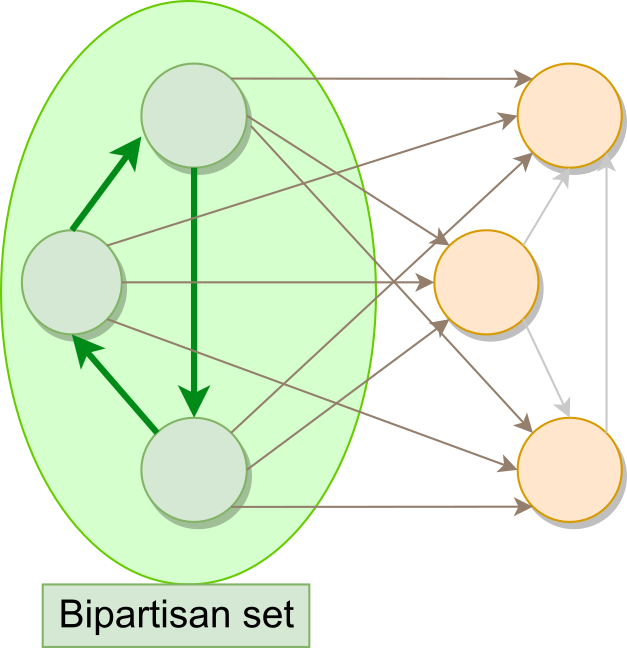The Bipartisan/Range Method
I. Principles
The election consists of two rounds, with the second potentially being instantaneous:-
In the first round, each voter ranks the candidates.
Most of the time, there is a "Condorcet winner" (i.e., a candidate who beats all other candidates in pairwise comparisons of number of vote) and they are elected.
Otherwise, it is a "Condorcet Paradox" (e.g., A>B, B>C, and C>A). Then, a leading group, called the Bipartisan set is determined (see below). - In the second round, if a Condorcet Paradox exists, voters assign a score between 0 - 100% to each candidate within the Bipartisan set.
The candidate achieving the top average score is elected.
II. How the Bipartisan Set is Formed
The formation of the Bipartisan set is reminiscent of strategic games like Rock-Paper-Scissors. This comparison allows us to better understand the process involved.
A. The Graph of Duels
Firstly, envision the candidates as game elements, like rock, paper, or scissors. To determine the relationships between them, we create a "Graph of Duels". In this graph, each candidate is represented as a node. When one candidate is preferred over another in pairwise comparisons, a directed arrow is drawn from the winning candidate's node to the losing candidate's node. An example of this graph is displayed below:

It's crucial to note that the formation of the Bipartisan set is dependent solely on this graph's structure and not the number of votes each pairwise comparison has garnered.
B. Identifying the Optimal Strategy
For every configuration of the graph, there exists an optimal, unbeatable strategy, just as there is in games like Rock-Paper-Scissors. Taking Rock-Paper-Scissors as an instance, playing each of Rock, Paper, and Scissor 1/3 of the time constitutes an unbeatable strategy. This means no other strategy can expect to outperform it in the long run. However, if we tweak the rules so that paper loses to rock, then the optimal strategy shifts to always choosing Rock. In this altered game, Rock becomes the only element in the Bipartisan set.
In essence, the Bipartisan set is constructed by analyzing a graph of duels, identifying the optimal, unbeatable strategy, and selecting candidates that have a non-zero probability in this strategy.
C. Examples of the Bipartisan Set in Action
Example 1:
For a scenario with A > B and A > C, in a game like Rock-Paper-Scissors, one would have to choose A to maximise its chances of winning. A emerges as the clear victor, named the Condorcet winner.

In this more intricate scenario, if we apply the Rock-Paper-Scissors game mechanics, there is no interrest in playing D, as it is always beaten by A, B, and C. But there is a cycle (a Condorcet paradox) between A, B, and C. The optimal strategy would then be: P(A) = P(B) = P(C) = 1/3 , and P(D) = 0. Thus, the Bipartisan set consists of {A, B, C}. Consequently, a second round is initiated where candidates A, B, and C are range voted upon.

An even more complicated case, there is still a cycle between A, B, C but this tie D manages to beat a leading candidate (A). However, it can be viewed as a sub-clone of C. Every duel that D wins is also won by C, and C surpasses D. Translating this to a Rock-Paper-Scissors-like game, it's consistently more beneficial to choose C over D. The unbeatable strategy remains P(A) = P(B) = P(C) = 1/3 , and P(D) = 0, leading to the Bipartisan set being {A, B, C}.

Just for fun, or for headheck, this example shows that it can be even more complicated. D would be almost a subclone of A but he wins against E whereas E beats A. This time to show that the optimal strategy is P(A) = P(B) = P(C) = 1/3 , and P(D) = P(E) = P(F) = 0, we have to see that each element is beaten at least as often as he wins against this strategy, and indeed:
- A wins 1/3 of times against C, but looses 1/3 of time against B (tie with itself in 1/3 of time)
- B wins 1/3 of times against A, but looses 1/3 of time against C
- C wins 1/3 of times against B, but looses 1/3 of time against A
- D wins only 1/3 of times against C, but looses 2/3 of time against A and B
- E wins only 1/3 of times against A, but looses 2/3 of time against B and C
- F wins only 1/3 of times against B, but looses 2/3 of time against A and C
III. Why not taking more candidates ? (The Smith set ?)

The Smith Set comprises candidates who can beat all others outside of the set in pairwise comparisons. In the example beside, we see the difference between the Smith Set and the Bipartisan Set.
The advantage of the Bipartisan set over the Smith Set is its ability to provide a refined selection during the first round, thus simplifying the range voting process and limiting influence of strategic voting.
Indeed, in the example 4 above, if a voter has approximately linear preferences over 6 candidates (i.e., approvals are A:1, B:0.8, C:0.6, D:0.4, E:0.2, F:0) and if the top two candidates on the overall list are B and C, this voter should set A:1, B:1, C:0, D:0, E:0, F:0. In doing so, they have 5 times more influence in electing B over C than if they rated sincerely. The more candidates there are, the more significant this ratio may be statistically, and thus range voting can be considered better when the number of alternatives is low and this is a reson to choose the Bipartisan Set over the Smith Set.
Additionally, the Bipartisan set eliminates irrelevant "clones", ensuring they do not interfere with the remaining of the election.